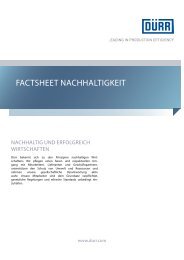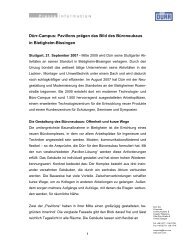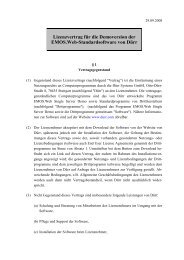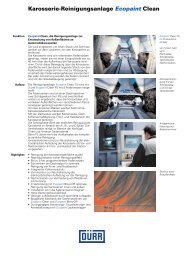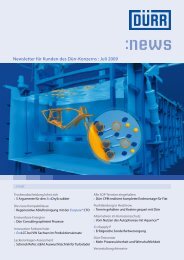Technologies · Systems · Solutions - Dürr
Technologies · Systems · Solutions - Dürr
Technologies · Systems · Solutions - Dürr
You also want an ePaper? Increase the reach of your titles
YUMPU automatically turns print PDFs into web optimized ePapers that Google loves.
Investments in associates<br />
Financial instruments<br />
Other financial assets<br />
Consolidated financial statements of <strong>Dürr</strong> AG<br />
93<br />
Companies over which <strong>Dürr</strong> does not exert a significant influence are recorded as investments in<br />
associates. The Group’s share of profits and losses is shown in the consolidated balance sheet<br />
as a change in the carrying amount and recognized in the consolidated income statement under<br />
share of profit of associates. Dividends received are deducted from the carrying amount.<br />
Pursuant to IAS 39, financial instruments are classified in the following categories:<br />
financial assets held for trading<br />
held-to-maturity investments<br />
loans and receivables originated by the enterprise and<br />
available-for-sale financial assets.<br />
Financial assets with fixed or determinable payments and fixed maturity that the Company<br />
intends and has the ability to hold to maturity – other than loans and receivables originated by the<br />
enterprise – are classified as held-to-maturity financial assets. Financial assets that are acquired<br />
principally for the purpose of generating a profit from short-term fluctuations in price are classified<br />
as held-for-trading financial assets. All other financial assets apart from loans and receivables<br />
originated by the company are classified as available-for-sale financial assets.<br />
Held-to-maturity financial assets are disclosed under non-current assets unless they are due<br />
within 12 months of the balance sheet date. Held-for-trading financial assets are disclosed<br />
under current assets. Available-for-sale financial assets are disclosed under current assets if<br />
the management intends to sell them within 12 months of the balance sheet date.<br />
Purchases or sales of financial assets are accounted for using the trade date method.<br />
The initial recognition of a financial asset is at cost, which corresponds to the fair value of the<br />
consideration given or received; transaction costs are included.<br />
Changes in the fair value of held-for-trading financial assets are recorded in the net profit or loss.<br />
For this purpose, the fair value of a financial instrument is the amount that can be generated<br />
for the asset in an arm’s length transaction between knowledgeable and willing parties, under<br />
current market conditions.<br />
Held-to-maturity financial assets are measured at amortized cost using the effective interest<br />
rate method. If it is more likely than not that the value of financial assets measured at amortized<br />
cost is impaired, the impairment is recorded against earnings. If an impairment loss recorded<br />
in a prior period decreases and the decrease in the impairment (or a write-up) can be objectively<br />
related to an event occurring after the impairment loss, the write-up is included in net profit<br />
or loss. A write-up cannot, however, exceed the carrying value that would have been recognized<br />
without the impairment.<br />
Loans and receivables originated by the enterprise and not held for trading are measured at<br />
amortized cost or the lower net realizable value on the balance sheet date.<br />
Available-for-sale financial assets are accounted for at market value. Unrealized gains and losses<br />
are disclosed in other comprehensive income, net of a tax portion. The reserve is released to profit<br />
or loss either upon disposal or if it is impaired.<br />
The marketable securities disclosed under other financial assets are classified as available-for-sale<br />
securities and therefore measured at market value on the balance sheet date. There were no<br />
adjustments to other comprehensive income in the reporting periods 2004 and 2003 as the<br />
unrealized changes in fair value were immaterial.




